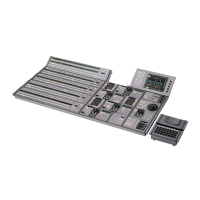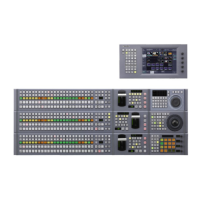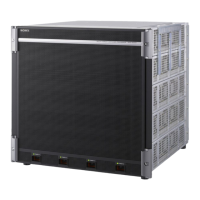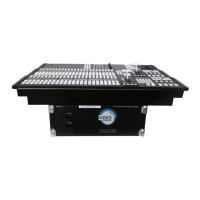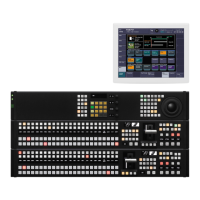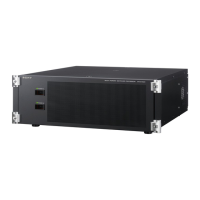Names and Functions of Parts of the Control Panel
• The buttons in this row select the key 2 or
key 4 signals to be inserted into the video
on this M/E bank or PGM/PST bank.
• To select the key 2 fill signal, check that the
right-hand [KEY4] button in the M/E bank
(or the [DSK4] button in the PGM/PST
bank) is off, then press the button assigned
to the desired signal.
• To select the key 4 fill signal, press the
[KEY4] button, turning it on.
• While the [UTIL] button on the right hand
side is held down, these buttons are
assigned to the DME utility 1 or 2 bus as
follows.
When the [KEY4] button is off: DME
utility 1 bus
When the [KEY4] button is on: DME utility
2 bus
• Press to select the signal as the current
background video on this M/E bank or
PGM/PST bank.
• While the [UTIL] button on the right hand
side is held down in Hold mode, these
buttons are assigned to the utility 1 bus,
and can be used to select the signal on that
bus.
• Press to select the signal as the
background video after the transition on this
M/E bank or PGM/PST bank.
• While the [UTIL] button on the right hand
side is held down in Hold mode, these
buttons are assigned to the utility 2 bus,
and can be used to select the signal on that
bus.
• These allow you to select the video created
on another bank as background A or B or
one of the keys 1 to 8.
• For example, to use the video created on
the M/E-1 bank as background B on the M/
E-2 bank, press the reentry button [M/E 1]
in the background B row of buttons on the
M/E-2 bank.
Chapter
2
Menus
and
Control
Panel
Assigning a delegation function to the key
1 row
You can assign the key/AUX bus delegation function to
the key 1 row so that signals can be selected in the key 2
row.
For details, see “Assigning a Key or AUX Bus to a Button
in the Key 1 or Key 2 Row” in Chapter 19 (Volume 2).
b
XPT (cross-point) HOLD buttons
Turning one of these buttons on enables you to recall a
keyframe or snapshot while keeping the current cross-
point selection unchanged.
Function of this button varies depending on the operation
mode selected in the Setup menu.
For details, see “Selecting the Bank to Make the Settings”
in Chapter 20 (Volume 2).
c
Key bus selection buttons
With the following buttons you can assign the key 1 or key
2 cross-point buttons to the key 3 or key 4 fill bus.
Press this button, turning it on, to assign the
key 1 cross-point buttons to the key 3 fill bus.
Press this button, turning it on, to assign the
key 2 cross-point buttons to the key 4 fill bus.
Cross-point button numbers
Cross-point button and reentry buttons are respectively
numbered (see page 92).
Assigning signals to button
You can assign a signal to each button using the Setup
menu.
For details, see “Cross-Point Settings (Xpt Assign Menu)”
in Chapter 19 (Volume 2).
Visual indications on cross-point buttons
For details, see “Colors of lit cross-point buttons” (page
94).
Pressing one of the key delegation buttons [KEY1] to
[KEY4] in the transition control block (standard type)
twice in rapid succession changes the state of the
corresponding one of these buttons, so that you can make
cross-point selections on the key bus (see page 40).
Using these buttons and the dedicated [SHIFT] button, you
can assign keys 5 to 8 to cross-point buttons (see page
398).
d
UTIL (utility) button
While this button is held down, the cross-point buttons are
assigned to the following buses, respectively.
Background A row: utility 1 bus
Background B row: utility 2 bus
Key 1 row: DME external video bus
Key 2 row: DME utility 1 bus when the [KEY4] button is
off, or DME utility 2 bus when the [KEY4] button is
lit.
In a Setup menu, you can select either of the following two
modes for these buttons.
•
The button takes effect while being held down.
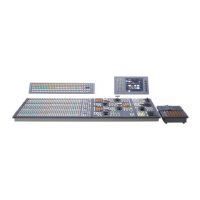
